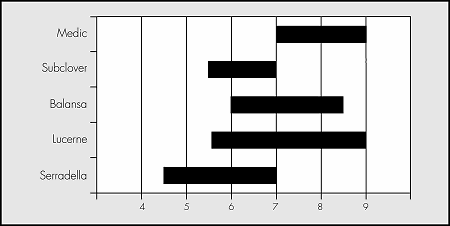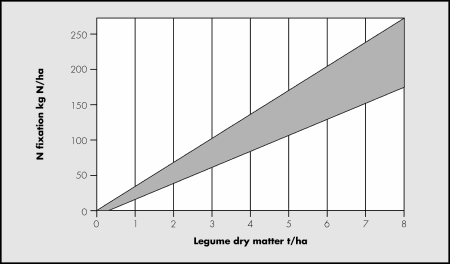
4.6 Free nitrogen from the air
by Ross Ballard, SARDI.
Bacteria fix nitrogen
Legumes (clovers and Lucerne)
‘fix’ nitrogen from the air into a form which can be used by the plant.
This process is carried out by the bacteria, Rhizobia sp, which live in
the nodules on the legume root.
“Rules of thumb”
Nitrogen fixation
For each tonne of legume dry
matter, 25kg of nitrogen is fixed.
A reasonable legume pasture
may fix 125kg of nitrogen per hectare.
That is equivalent to 270kg
of urea.
Different legumes fix and use
different levels of nitrogen. |
Symbiosis
This is a symbiotic
relationship, the plant receives nitrogen and the bacteria receive sugars.
Slow release fertiliser
Nitrogen fixed by a legume is
organic nitrogen and acts like a slow release fertiliser.
It becomes available to the plant as the plant residues are decomposed by
other soil organisms. The process
of converting organic nitrogen to the inorganic form which is available to
plants is called mineralisation. Grasses,
cereals, or the legume may take up this inorganic nitrogen.
Graph
1:
Preferred pH range
for common pasture legumes

Soil texture and rainfall
will also impact on growth.
Horses for courses
Different legumes need
different rhizobia. Clover rhizobia
will not nodulate lucerne. Equally,
lucerne rhizobia will not nodulate vetch. Hence,
if you sow a new legume in a paddock, inoculation should be practised. Ensure you use the correct
inoculant strain.
“Rules
of thumb”
Assessing nitrogen fixation
When
Plants are best assessed 8-10
weeks after germination.
Where
There should be at least five
red nodules close to the top of the root system.
Red nodules
Sometimes the nodules needs
to be cut to see the red colouration.
White nodules
Numerous white nodules
scattered over the roots indicate the symbiosis is not fixing nitrogen.
Old nodule
Active nodules (red) may turn
green as their n-fixation activity declines with age or plant stress.
In subclover plants at flowering, it is common to observe that whilst the
section of nodule close to the plant root is green, the nodule tip remains red.
This red area of the nodule is still fixing nitrogen.
|
Rhizobial inoculants are alive
Remember that rhizobial
inoculants contain living bacteria. They
are fragile. Do not expose them to
excessive temperatures or freeze them. Avoid
mixing them with pesticides and fertilisers.
Sow seed as soon as possible after inoculation, into a moist seedbed.
Rhizobia require warm moist
soil conditions. They must be the
correct species for the legume so that nitrogen fixation occurs.
Factors that will limit nitrogen fixation:
Impact of pH
Soil pH can be the major
limitation to a good symbiosis (see Graph 1).
Nitrogen fixation by
subclover may decline where soil pH falls below 5.
Whilst there are often still rhizobia in the soil, their ability to
nodulate the clover may be reduced. Liming
to increase soil pH is the best solution.
Lucerne rhizobia are less
tolerant of low pH. They are rarely
found in soils where the pH is less than 6.
Hence, it is absolutely essential that lucerne seed is inoculated and
lime pelleted at sowing. Liming to
increase soil pH is also a good strategy.
Graph 2:
Approximate
relationship between amounts of nitrogen fixed and legume dry matter production

Based on Peoples et al, CSIRO

4.6 Free nitrogen from the air
[ Back ] [ Next ]
|
